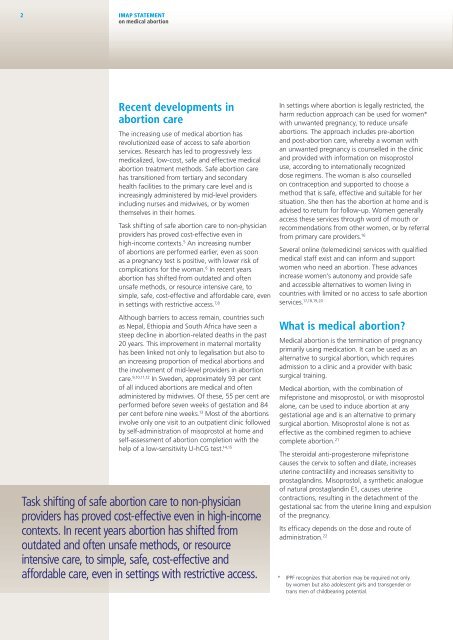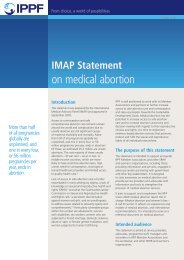ippf_imap_medical abortion
Create successful ePaper yourself
Turn your PDF publications into a flip-book with our unique Google optimized e-Paper software.
2 IMAP STATEMENT<br />
on <strong>medical</strong> <strong>abortion</strong><br />
Recent developments in<br />
<strong>abortion</strong> care<br />
The increasing use of <strong>medical</strong> <strong>abortion</strong> has<br />
revolutionized ease of access to safe <strong>abortion</strong><br />
services. Research has led to progressively less<br />
<strong>medical</strong>ized, low‐cost, safe and effective <strong>medical</strong><br />
<strong>abortion</strong> treatment methods. Safe <strong>abortion</strong> care<br />
has transitioned from tertiary and secondary<br />
health facilities to the primary care level and is<br />
increasingly administered by mid‐level providers<br />
including nurses and midwives, or by women<br />
themselves in their homes.<br />
Task shifting of safe <strong>abortion</strong> care to non‐physician<br />
providers has proved cost‐effective even in<br />
high‐income contexts. 5 An increasing number<br />
of <strong>abortion</strong>s are performed earlier, even as soon<br />
as a pregnancy test is positive, with lower risk of<br />
complications for the woman. 6 In recent years<br />
<strong>abortion</strong> has shifted from outdated and often<br />
unsafe methods, or resource intensive care, to<br />
simple, safe, cost‐effective and affordable care, even<br />
in settings with restrictive access. 7,8<br />
Although barriers to access remain, countries such<br />
as Nepal, Ethiopia and South Africa have seen a<br />
steep decline in <strong>abortion</strong>‐related deaths in the past<br />
20 years. This improvement in maternal mortality<br />
has been linked not only to legalisation but also to<br />
an increasing proportion of <strong>medical</strong> <strong>abortion</strong>s and<br />
the involvement of mid‐level providers in <strong>abortion</strong><br />
care. 9,10,11,12 In Sweden, approximately 93 per cent<br />
of all induced <strong>abortion</strong>s are <strong>medical</strong> and often<br />
administered by midwives. Of these, 55 per cent are<br />
performed before seven weeks of gestation and 84<br />
per cent before nine weeks. 13 Most of the <strong>abortion</strong>s<br />
involve only one visit to an outpatient clinic followed<br />
by self‐administration of misoprostol at home and<br />
self‐assessment of <strong>abortion</strong> completion with the<br />
help of a low‐sensitivity U‐hCG test. 14,15<br />
Task shifting of safe <strong>abortion</strong> care to non-physician<br />
providers has proved cost-effective even in high‐income<br />
contexts. In recent years <strong>abortion</strong> has shifted from<br />
outdated and often unsafe methods, or resource<br />
intensive care, to simple, safe, cost-effective and<br />
affordable care, even in settings with restrictive access.<br />
In settings where <strong>abortion</strong> is legally restricted, the<br />
harm reduction approach can be used for women*<br />
with unwanted pregnancy, to reduce unsafe<br />
<strong>abortion</strong>s. The approach includes pre‐<strong>abortion</strong><br />
and post‐<strong>abortion</strong> care, whereby a woman with<br />
an unwanted pregnancy is counselled in the clinic<br />
and provided with information on misoprostol<br />
use, according to internationally recognized<br />
dose regimens. The woman is also counselled<br />
on contraception and supported to choose a<br />
method that is safe, effective and suitable for her<br />
situation. She then has the <strong>abortion</strong> at home and is<br />
advised to return for follow‐up. Women generally<br />
access these services through word of mouth or<br />
recommendations from other women, or by referral<br />
from primary care providers. 16<br />
Several online (telemedicine) services with qualified<br />
<strong>medical</strong> staff exist and can inform and support<br />
women who need an <strong>abortion</strong>. These advances<br />
increase women’s autonomy and provide safe<br />
and accessible alternatives to women living in<br />
countries with limited or no access to safe <strong>abortion</strong><br />
services. 17,18,19,20<br />
What is <strong>medical</strong> <strong>abortion</strong>?<br />
Medical <strong>abortion</strong> is the termination of pregnancy<br />
primarily using medication. It can be used as an<br />
alternative to surgical <strong>abortion</strong>, which requires<br />
admission to a clinic and a provider with basic<br />
surgical training.<br />
Medical <strong>abortion</strong>, with the combination of<br />
mifepristone and misoprostol, or with misoprostol<br />
alone, can be used to induce <strong>abortion</strong> at any<br />
gestational age and is an alternative to primary<br />
surgical <strong>abortion</strong>. Misoprostol alone is not as<br />
effective as the combined regimen to achieve<br />
complete <strong>abortion</strong>. 21<br />
The steroidal anti‐progesterone mifepristone<br />
causes the cervix to soften and dilate, increases<br />
uterine contractility and increases sensitivity to<br />
prostaglandins. Misoprostol, a synthetic analogue<br />
of natural prostaglandin E1, causes uterine<br />
contractions, resulting in the detachment of the<br />
gestational sac from the uterine lining and expulsion<br />
of the pregnancy.<br />
Its efficacy depends on the dose and route of<br />
administration. 22<br />
* IPPF recognizes that <strong>abortion</strong> may be required not only<br />
by women but also adolescent girls and transgender or<br />
trans men of childbearing potential.




